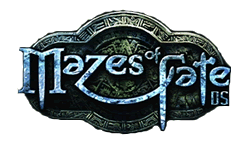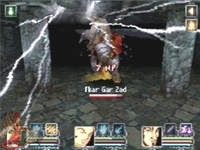|
|

|
PLATFORM
|
DS
|
BATTLE SYSTEM
|

|
INTERACTION
|

|
ORIGINALITY
|

|
STORY
|

|
MUSIC & SOUND
|

|
VISUALS
|

|
CHALLENGE
|
Easy to Moderate
|
COMPLETION TIME
|
10-15 hours
|
|
OVERALL

|
Click here for scoring definitions
|
|
|
Mazes of Fate DS is a remake of the Game Boy Advance game of the same name. The large differences between the two versions lie solely in the gameplay--Mazes of Fate DS utilizes the stylus rather heavily. The story remains unchanged.
Evil stalks the land. The peasants complain about having strange dreams. Shadows are seen entering forbidden temples. Rumors of war are on the lips of practically everyone. Players will need to solve these mysteries to progress in the game. While not particularly well-written or engaging, the story is nonetheless charming. The game shines during conversations with NPCs: based on the player's stats, different options are available. These options can lead NPCs to join or leave the party, and can lead to quests being solved in different ways. For example, a charismatic player might be able to talk their way out of a fight. Players will find themselves coercing street toughs and drinking in all the taverns to gather the information necessary to continue in the game.
Like most RPGs, Mazes of Fate DS has a primary storyline as well as numerous side quests. In the vein of Mass Effect, the player will not be spending too much time on the side quests as they tend to be only five to ten minutes in length. The primary quests take much longer.
The game takes place in the Kingdom of Karsh. There are no wandering peasants or monsters in either the towns or the overworld. Movement is done by dragging the stylus, or by using the d-pad. Buildings and areas are entered by tapping them with the stylus. As information is gathered, new areas are added to the various maps. Different parts of the overworld are accessed through transition zones. Going through such a zone once is enough; subsequent visits allow players to choose to warp to the other side.
The meat of the game is in the dungeons, as is the wont of the dungeon crawling subgenre. The main difference between Mazes of Fate DS and the original is how these dungeons are explored. Whereas the original was like Orcs & Elves with tile-based movement, this iteration allows for free movement using the d-pad to move and strafe and the stylus to turn. The sensitivity is a little low, so turning can be a chore, but thankfully the shoulder buttons can be used to turn much more quickly. Another little issue here is that even though free movement is used, it is not possible to avoid some pits and traps by walking between them--the game still treats it as tile-based movement and as soon as those tiles are entered the traps are triggered.
 You really need a shower--a Meteor Shower!
You really need a shower--a Meteor Shower!
|
|
Dungeons come in all shapes and sizes. Players will need to find hidden passages, treasure chambers, switches, and teleporters. Often keys are necessary to continue and can be a chore to find if missed. Luckily, the game comes with a good auto-mapping feature, so backtracking and opening missed chests and finding unexplored regions becomes almost trivial.
Monsters are fought with a click of the stylus. Each action has a cooldown time, which can be modified by skills. Spells can be pulled from a menu and aimed using the stylus. This is where the game really shines as the combat is fun. Unfortunately, monsters don't come in that large of a variety and they don't usually change up their tactics at all. The change in movement since the original has likely harmed the game. Monsters move much too slow, allowing players to dart in and out of melee range. A suitably powerful warrior character can often dart in and kill the monster before they have a chance to get in a return hit. In fact, this is often the case up to and including the final boss. Thankfully, this doesn't change the fact that tapping the screen wildly is a lot of fun.
On the topic of play control, the game plays very well. Dungeon exploration is enjoyable, but there are still a few complaints with the overall interface. Because of the way the game plays, some vital text can be missed if the player moves about with the stylus constantly on the screen. The use of the DS screens is well done. The bottom screen is used for all the action while the upper screen is used to show character stats and map screens.
The player is able to choose between five preset characters when starting the game. They can also choose to create their own. When creating a character, the player can set their stats as they see fit. They are given 100 stat points and four skills points. The stat points can be used to modify the character's primary attributes in any way (as long as each is in the range of ten and fifty). The skill points are used to purchase combat, rogue, and magic skills. Each level awards three skill points. Accuracy with weaponry, attack speed, lockpicking, searching, and spell power are all things that can be improved. Leveling magic skills increases the variety of available spells, as well.
 I always said he had a really shocking personality!
I always said he had a really shocking personality!
|
|
There are certain things that need to be done to successfully get through a dungeon. Luckily a single character does not need to do it alone. Over the course of the journey it is possible for other characters to join the party. By spreading out responsibilities between them, they can do their tasks much better than they could on their own.
The challenge in the game varies wildly depending on the player's choice in character. A hero with a maxed out strength of fifty is likely to plow their way through any obstacle--should they be able to hit it. Most of the combat difficulty comes from not seeing the enemy before it gets a chance to hit, or constantly missing and being backed up into a corner. Just as the player can plow through monsters, most monsters can do the same to players. A good portion of monsters can easily kill a hero in one or two hits.
Healing is pretty much free in the game. The player should pick up ten healing items for every one that they will actually use. Furthermore, players are allowed to rest and save pretty much everywhere, further decreasing the challenge to be found.
The graphics are not the best or the worst that the DS has to offer. Having not played the original version it is hard to judge if there were any improvements in this area. The special effects, character models, and dungeons are just dreary. It is difficult to distinguish between different areas as everything looks the same. That being said, there are no noticeable issues with the visuals leaving it in the realm of the average.
The music also has its ups and downs. The sound effects are standard fare, and there are some tracks that are really pleasant to listen to, but the majority of the time is spent listening to some really bad music. The game is more enjoyable if played with the sound off.
All in all, Mazes of Fate DS is a catch for those that love dungeon crawlers. If the reason for playing it is to find a good storyline, it is best to just pass this title by. While the game plays really well, the graphics are average and the music is atrocious. It does allow for a lot of customizability and even offer a lot of replay for those that want to play it again in a different way.
Review Archives
|









